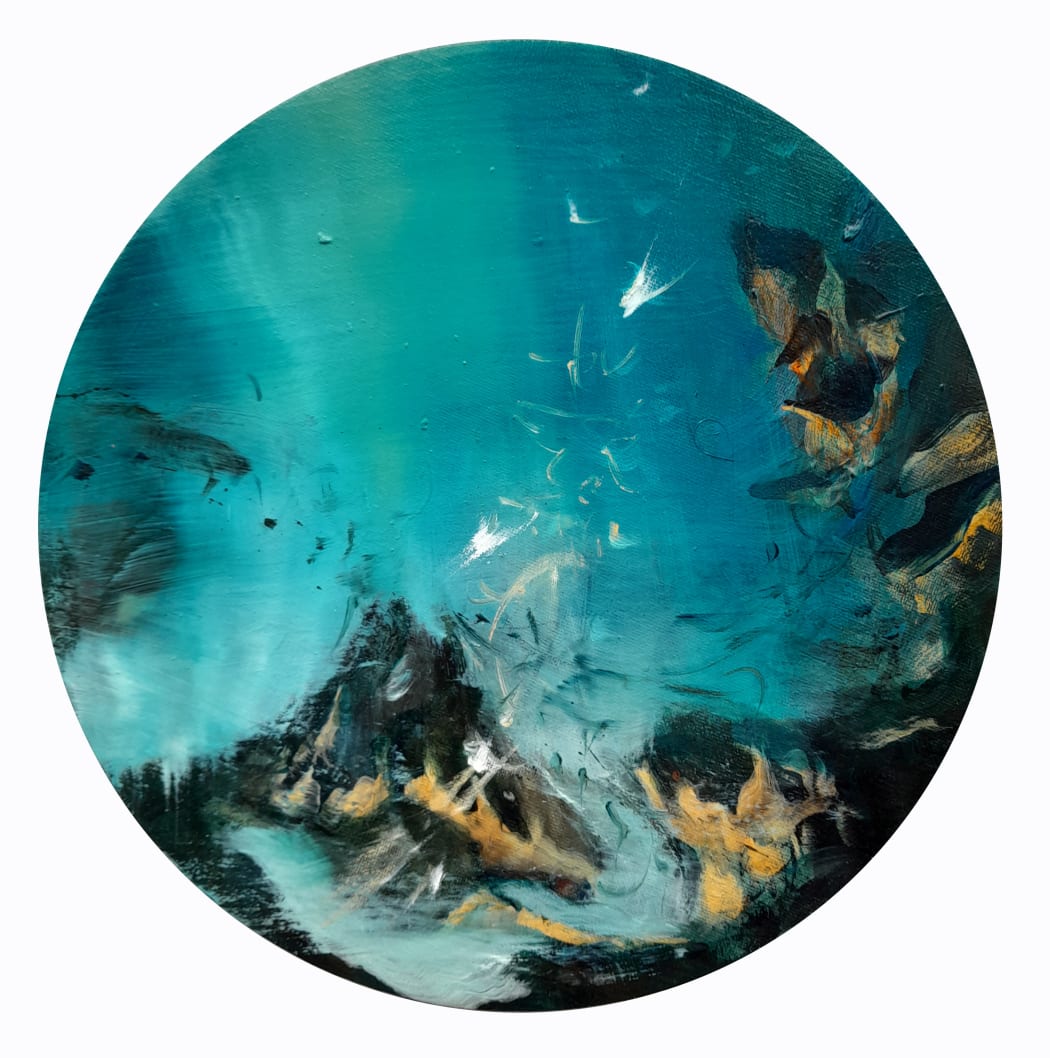
1) You mentioned that you are a musician and use music to enhance your art-making process. Can you talk more about how you integrate music and visual art in your creative process and what inspired you to combine these two mediums?
I got into playing music and learning to make art around the same time in my early teens so I’ve always felt like the two things are connected. My first loves in music were albums with cover art that I would pour over for hours. I sometimes joke that my art has a dash of prog rock album covers in it but actually there is a lot of truth in it. The magical, fantastic landscapes I stared at for so long in my youth definitely reappear in my art today.
In my graphic design career I loved doing album covers - mostly for classical music but also a few for rock bands, some jazz, choral music, traditional Maori music, musicals and even some spoken word poetry. When we didn’t have a good image to use or budget to create something I often painted abstracts to help visualise the music for the album cover.
Music is always playing in the studio. Sometimes it is just there to create a mood but sometimes I use the music to specifically shape the art I’m making. This can be in terms of the words in the music as inspiration or it can be the sounds that shape the rhythm of the strokes in the painting. I feel that my abstract work has some kind of rhythm underneath it. People have said my work has a lot of movement. I’m trying to represent the flow of energy in the universe and I think sound waves are a big part of that.
During my recent solo exhibition at the Old Lock Up Gallery in Cromford, Derbyshire I did a day of live painting and used some ambient music that I have been making for the last few years as a soundtrack. The music and art seemed to work well together in the gallery space.
2) In our current exhibition, ‘Rhythm in Art,’ you are exhibiting three abstract paintings, and you mention how you used jazz albums to help guide you in creating them. How do you interpret the music from the jazz album into visual elements such as color, rhythm, and texture in your paintings?
The Jazz Abstract series was an earlier series I created a few years ago and occasionally revisit. I’ve attached a couple of works from the series. 'Bright Size Life' inspired by Pat Metheny’s album of the same name, and ‘Eternity’s breath’ inspired by a track from Mahavishnu Orchestra’s 'Visions of the Emerald Beyond’ album. The series was a conscious attempt to try to break away from making representational images by responding directly to the sound of the music. Interestingly they still look vaguely like imaginary landscapes and probably not that different to my other work. I just find it important to keep setting myself little challenges like this to gently stretch my creative muscles. Eventually the future work always benefits. This series also taught me that my work is always inspired by nature and my connection to the landscape even if it is only subconscious when I’m working in the studio.
The three pieces in the exhibition are inspired by three of my favourite songs. "A vision softly creeping, Left its seeds while I was sleeping” is a line from Simon and Garfunkel’s Sound of Silence. "Half of the time we're gone, But we don't know where” is from another Simon and Garfunkel song called ‘Last living boy in New York’. 'Words are flowing out like endless rain’ is a line from 'Across the Universe' by the Beatles. For these pieces the sound of the music shaped the choice of colours and forms in the paintings and the meaning of the specific lines had a direct influence on the paintings. Again I can’t help but use natural elements as the shapes and forms in the works.
3) What motivated you to pursue an art career, and did you anticipate the difficulties you would encounter?
It was never meant to be a career. I studied graphic design and worked as a designer for about 30 years. Painting was a hobby that grew into some illustration work for design projects and gradually the art making became a bigger part of my life as I began to do art exhibitions at the same time as running a design business. When I sold the design business in 2017 it seemed the logical time to go full time with the art.
Yes, the difficulties were no surprise. I’d had decades of rejection, underwhelming sales and criticism doing group art shows whilst still a designer so I was well prepared!
4) Can you describe a specific moment or period when you felt particularly discouraged as an artist? And how did you find the strength to keep going?
Constant rejection from galleries can be soul destroying. You’ve just got to understand it from the other side - galleries get so many applications from artists that it’s easy to disappear in the deluge of emails they receive. You have to understand that a gallery owner has limited space, they may have a niche that they specialise in which is different to your work, they may have a stable of artists that already includes someone doing very similar work to yours, or they might just not like it - doesn’t mean it’s good or bad, just not their taste. Just keep going, try lots of galleries, get organised with a spreadsheet so you can make notes on any feedback they give, make a note to follow them up and send new work every few months as you develop. Be prepared to travel - I only have one gallery in my area (Leicester) who have been interested in my work so I’ve had to form relationships with galleries from Newcastle to Manchester to Brighton.
5) You talk about the business side of being an artist and the struggles that come with it. What role does self-doubt or criticism play in your creative process, and how have you used these experiences to grow as an artist?
Self criticism is vital to improve but it can also become debilitating. Be aware of your mental well being and the role art making plays in it. What I mean by that is that things change - sometimes deadlines can be a good for focus, sometimes they can add huge stress. Use self doubt to make yourself a stronger artist - ie if you’re stuck or feeling not good enough remember that questioning is good. Look at other artists to see how they problem solve, learn by reading about their techniques and inspiration. Develop strategies for what to do when you get stuck creatively.
Listen to criticism and learn from it. You can choose how much if any of it you want to implement in your work but listen very carefully so you can make informed choices in future work. Don’t get angry or depressed - think about how many times you’ve watched a movie or listened to song and said ’that’s crap’. It doesn’t mean the creator is a worthless human being it just means that work doesn’t work for you for any number of different reasons.
6) Can you share a piece of advice or wisdom you've gained from your experiences as an artist that might help others who are facing similar challenges?
Clients can be demanding. Some galleries don’t pay you. Some galleries give you back artwork damaged… on and on it goes. But that’s like any business, there will always be challenges. Getting paid is tough in any business but it’s particularly hard in the art world. You have to do your research to price your work realistically - don’t go too cheap, nobody will think you have any worth, don’t go ridiculously high as no gallery will want your work. Talk to the galleries, get advice on how they like their work framed, price point, size and orientation they prefer, how often they want to hear from you with new work, suggest meeting their clients, be open to doing commissions etc. Don’t over-commit. If you say you’re going to deliver something by a certain date make sure you do (or communicate with the client or gallery owner well in advance if you need to ask for more time). Professionalism is vital.
The other part of the business side that is tricky is weeding out the scammers. Any approach on Insta or FB should be approached with extreme caution. I’ve made some genuine sales from social media and some good relationships with galleries and interior designers. But mostly it’s scams such as the NFT people who want you to put up money so they can mint/mine the tokens on their server. They promise vast sales but in reality they’ve charged you a lot of money to create something that will sit unseen and unprompted on their server (if they actually make the token at all). All I can say is do your research. If a gallery in New York says ‘hey we’d love to exhibit your work’ Google them. Chances are there will be lots of artists talking about how they paid a lot of money for a tiny amount of space in a gallery that never did any promotion (why would they, they’ve already covered their costs without needing to sell any art). This isn’t a scam as such, it’s know as pay-to-exhibit or vanity exhibiting or pay-to-play.
Develop a system for commissions - I take a deposit, a detailed brief, ask loads of questions, get the client to choose from examples of my previous work and show work in progress so the client feels part of the process and there are no nasty surprises for them or a rejection for you at the end.
Write lots… about your thoughts and feelings, your process, what’s inspiring you, what you intend with the next body of work, what you’re aiming for. You don’t have to show anyone else. Write lyrics, poetry, short stories, a journal, letters to yourself or other people - whatever helps you get those thoughts down on paper will help shape your ideas as an artist.


